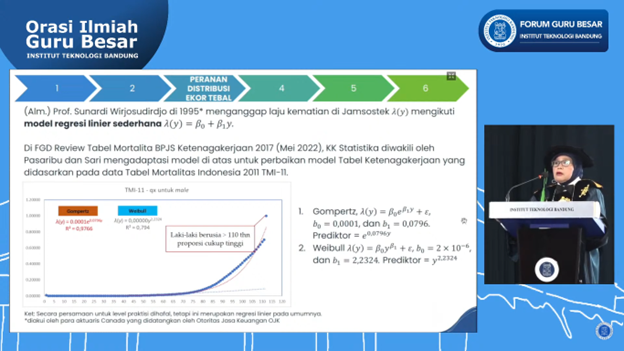Prof. Udjianna Sekteria Pasaribu: A Stochastic Model of Heavy-Tailed Distribution for Developing Risk Management

BANDUNG, itb.ac.id — Prof. Udjianna Sekteria Pasaribu, Ph.D., delivered her scientific oration to ITB professors at the West Hall of ITB on Saturday (29/10/2022). With her presentation "The Role, Potential, and Challenges of Developing Stochastic Models from Heavy-Tailed Distribution", the professor from the ITB FMNS (Faculty of Mathematics and Natural Sciences) Statistics Research Group emphasized the importance of survival models in various study fields.
One of the methods in determining the survival function is to use the heavy-tailed distribution method- a probability distribution indicating excess kurtosis. This distribution type describes the outliers of an event into a large area. Because of this, its distribution is widely used to measure the chances of an unusual occurrence.
"Calculating the normal distribution is no longer appropriate when measuring risk. The normal distribution can determine the value of the minimum risk, but it is represented by a small percentage. If we look at the distribution result of the heavy-tailed method, the percentage turns out to be larger. The approximation of the asymmetric heavy-tailed distribution represents the data more than the normal distribution.” Prof. Udjianna explained.
Quoting the study done by Nair et al (2022), most practitioners avoided using heavy-tailed distribution due to its difficult model. Moreover, its distribution is often surprising with the addition of the Gaussian Central Limit Theorem.
Functioning on relatively difficult odds makes the heavy-tailed distribution unfamiliar to many. Its unpredictable and ambiguous nature in the world of statistics often causes new topics and research about its data to emerge.

Albeit its complexity, the heavy-tailed distribution is better in terms of the effectiveness of the distribution. It is highly advised by experts to use this distribution type when dealing with insurance and risk management. In Indonesia, heavy-tailed distribution is frequently used for determining mortality rate models in social security, BPJS risk calculations, insurance companies, and more.
There are still major challenges in the usage of heavy-tailed distribution. In the development of institutions run by practitioners, its long numerical processes are less favored, especially for oversized data. Moreover, the normal distribution is already popular for its practical uses despite its deviation of the resulting survival function. Faced with this matter, scientists must find ways to boost the use of heavy-tailed distribution by people working in the risk management sector.
"One of the ways is to convince insurance, medicine and engineering practitioners to try using heavy-tailed distribution with better estimated guarantees. Collaboration with the Statistics Research Group can help the industries to analyze the nature of the data from its distribution," Prof. Udjianna added.
In 1985, Prof. Udjianna completed her undergraduate education at ITB Mathematics study program. She then studied abroad at the University of Wales, Swansea majoring in biostatistics. She is now an active teaching staff of ITB for bachelor, masters, and doctoral students. Throughout her career as a professor, she has published more than 124 national and international journals and proceedings.
Reporter: Hanifa Juliana (Urban and Regional Planning, 2020)
Translator: Ruth Nathania (Environmental Engineering, 2019)

scan for download








